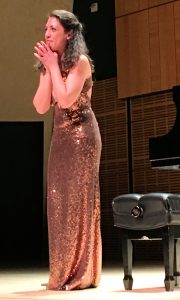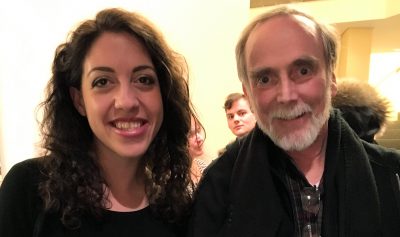Beatrice Rana
On Tuesday March 12th 2019, Italian pianist Beatrice Rana made her Carnegie debut at Carnegie’s Zankel Hall.
A 2013 Van Cliburn competition silver medalist (see this photograph) Beatrice at age 25 has been performing in major concert halls around the world for years.
Zankel is a modest venue of about 600 seats, hardly intimidating to an experienced international pianist. But the New York audience is notoriously demanding.
Ms. Rana came on stage in an elegant, floor-length sequined copper gown. If she was nervous, the only hint might have been how quickly she got down to business.
Chopin: Twelve Etudes Op. 25
The drape of the copper gown presaged the flowing arpeggios and modulations of the first Etude (“Aeolian Harp”, A-flat Major). Ms. Rana’s damper work allowed the harp-like sonorities of this etude to glow.
Throughout the Etudes, Beatrice Rana focused intently on the keyboard. She employed no visual theatrics, going little further than the occasional lift of her right eyebrow. Her left hand came nicely forward when voicing called for it. I personally liked her well-managed pedal, however some people would have preferred different handling of harmonics in certain Etudes.
Ms. Rana sailed through technical challenges such as the Op. 26 No. 6 (“Thirds”, G-sharp minor) and particularly Op. 26 No 11 (“Winter Wind”, A minor), where she showed her virtuosity and prodigious power.
The final Etude Op. 26 no 12 (“Ocean”, C-sharp minor) was masterfully executed. During this aptly-labeled Etude Ms. Rana rocked from side to side, following her hands. Swaying is intrinsic to this work, but her dinghy-like rock-and-roll was so pronounced that I wondered if it was intended as a metaphor for Chopin’s waves.
Ravel: Miroirs
Miroirs is an evocative 5-section suite for solo piano, a well-chosen programmatic bridge between Chopin and Stravinsky.
After Ms. Rana’s sublime pedalwork for Chopin, I looked forward to hearing her project the sonorities of Ravel. But although her delivery was fine, I was not entirely satisfied. I can’t point to anything specific, but it felt a little choppy.
Of course, it may be that the disconnect is on the reviewer’s side.
Stravinsky: Three Movements from The Firebird
This exciting piano transcription by Agosti of 3 sections from Stravinsky’s Firebird suite is a concert favorite. Beatrice Rana gave a spirited rendering. No harmonic muddying here! I loved her marcatissimo closing.
Encores
After the main program, Beatrice treated us to two encores by Chopin: Prelude in F# minor Opus 28 and Scherzo #18 in B flat minor. She has an obvious flair for Chopin, so it made for a fun ending to a great evening.
Meeting Beatrice
After the recital we went to the Carnegie “Mix and Mingle” event.
To our delight Beatrice (pronounced Bay-ah-tree-cheh) Rana herself came out to join us, friendly and accommodating to her fans.
Of all the questions I had for Ms. Rana, there was time for just one. So I asked her how it felt to walk out on stage at Carnegie for the first time. “Exciting”, she gleamed.
For more about Beatrice Rana, see her web site at www.beatricepiano.com.




You must be logged in to post a comment.